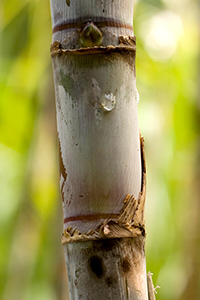Table of Contents
Sugar cane is native to Southeast Asia. The Arabs spread its cultivation throughout the Mediterranean, and then the Spanish and Portuguese carried it to America in the 16th century. Cane sugar is obtained from this plant, as well as molasses, also called cane honey, which is the syrup residue after separating the sugar crystals from the cane juice.

Sugar Cane Scientific Facts
- French: Canne a sucre.
- Spanish: Cana de azucar
- Environment: It grows in subtropical regions of southern Europe and tropical areas of Central and South America, mainly in Cuba.
- Description: A plant of the Gramineae family, it is similar to the standard cane. Its aerial stems (canes) grow up to 4 m high, and its flesh is sweet and juicy.
- Parts of the plant used medicinally: The stem (cane).

Healing Properties and Indications

Sugar cane juice contains saccharose, a disaccharide sugar whose chemical formula is C12H22O11. It also includes many mineral salts and vitamins, most of which remain in the molasses. Brown sugar (non-refined sugar) contains molasses, giving it its color; hence, it contains mineral salts and vitamins. However, refined sugar (white sugar) is pure saccharose, lacking other nourishing substances.
Sugar cane juice and the decoction of its flesh have pectoral stimulating and refreshing properties. It is recommended for people with bronchial catarrh, chronic bronchitis, or asthma.
How to use Sugar Cane
- Fresh juice, prepared by grinding sugar canes.
- Decoction, with 250 g of peeled sugar cane per liter of water.
Frequently Asked Question
Can sugar cane help improve liver function?
Some studies suggest potential liver-protective benefits. The plant contains compounds like polyphenols and flavonoids with antioxidant properties. These may help reduce inflammation and oxidative stress associated with liver damage.
Does sugar cane juice have a positive effect on gut health?
Potentially. Sugar cane juice contains fiber and prebiotics, which may support healthy gut bacteria. Traditionally, it’s been used for digestion-related issues.
Is it true that sugar cane can help boost immunity?
The plant contains vitamin C and antioxidants, which support a healthy immune system. Some research indicates flavonoids in sugarcane could have immune-modulating effects. However, it’s not a substitute for a balanced diet and healthy lifestyle for robust immunity.
I have diabetes. Can I safely consume sugar cane products?
Exercise caution. Although less processed sugarcane products like juice have a lower glycemic index than refined sugar, they contain carbohydrates that impact blood sugar levels. Consult your doctor for personalized advice.
Can sugar cane help with hydration?
Yes! Sugarcane juice is naturally high in water content and contains electrolytes like potassium. This makes it a decent hydrating option, especially after physical activity.
Are there significant nutrient differences between raw sugar cane, sugar cane juice, and molasses?
Yes. Raw sugarcane offers fiber, while juice has more concentrated sugars. Molasses, the byproduct of sugar refining, boasts the highest concentration of vitamins and minerals, such as iron, calcium, and magnesium.
Are there anti-inflammatory properties in sugar cane?
Early research suggests this potential. Sugarcane contains polyphenols that have exhibited anti-inflammatory effects in animal studies.
Does sugar cane have any topical uses for skin health?
It might. Traditionally, sugarcane juice has been used for wound healing. Some research points to the potential of sugarcane-derived compounds as skin protectants due to their antioxidant properties.
Are there proven medicinal uses of this plant supported by robust evidence?
While sugarcane has traditional medicine applications, many claimed benefits lack large-scale, conclusive human studies. Always talk to your doctor before substituting sugarcane for prescribed treatments.
Where can I find reliable information on this plant and its health effects?
Stick to scientific journals, research databases, and government health institutions like:
1. PubMed: https://pubmed.ncbi.nlm.nih.gov/
2. National Institutes of Health: https://www.nih.gov/
DISCLAIMER: All content on this website is presented solely for educational and informational objectives. Do not rely on the information provided as a replacement for advice, diagnosis, or treatment from a qualified medical expert. If you are pregnant, nursing, or have any preexisting medical concerns, talk to your doctor before using any herbal or natural medicines.
REFERENCES
- George D. Pamplona-Roger, M.D. “Encyclopedia of Medicinal Plants.” George D. Pamplona-Roger, M.D. Encyclopedia of Medicinal Plants. Ed. Francesc X. Gelabert. Vols. 1 San Fernando de Henares: Editorial Safeliz, 2000. 332. Print.
- Excellent Health Benefits Of Sugarcane Juice: https://pharmeasy.in/blog/15-excellent-health-benefits-of-sugarcane-juice/
- Cane Sugar: Are There Health Benefits?: https://www.webmd.com/diet/health-benefits-cane-sugar
- Surprising Health Benefits of Organic Sugar Cane: https://enjoybigcountry.com/blogs/blog/surprising-health-benefits-of-organic-sugar-cane-why-it-s-the-better-option
- Sugarcane health benefits you need to know: https://www.ndtv.com/health/sugarcane-health-benefits-this-sweet-snack-is-not-going-to-make-you-fat-and-offer-many-health-benefits-2526183
- Phytochemical profile of sugarcane and its health aspects: https://www.ncbi.nlm.nih.gov/pmc/articles/PMC4441162/
Last update on 2024-07-23 / Affiliate links / Images from Amazon Product Advertising API

